Top 8 Software Development Models For Your 2025 Projects (Agile, Waterfall & More)
Software development models show how to navigate the complex and demanding process of building software. A project’s quality, timeframes, budget, and ability to meet stakeholders’ expectations largely depend on the chosen model, so choosing the right software development model makes all the difference. However, there are more than 50 recognized software engineering practices in use nowadays, and each brings its favorable aspects and disadvantages for a specific software development project or team.
With more and more software development trends rising, Savvycom, as your trusted project management company, has chosen 08 most popular software development models to show you their core features and how they would benefit your business.
1. Waterfall
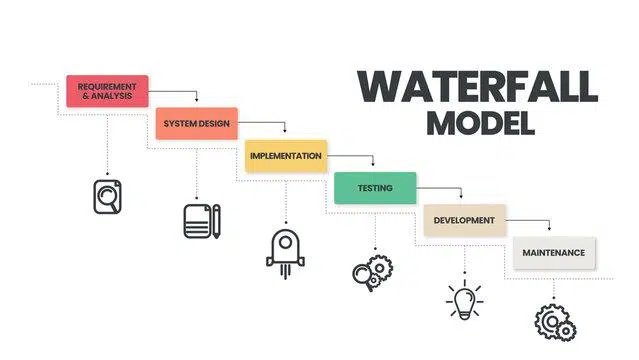
The preliminary model we’ll discuss is the waterfall software development process – Image Source: Adobe Stock.
The Waterfall model moves cascaded through all development stages (analysis, design, coding, testing, and deployment). Each step has specific deliverables that are meticulously documented. The following stage cannot begin until the preceding one has been completely finished. As a result, software requirements, for example, cannot be re-evaluated during development. Furthermore, there is no way to examine or try the software until the final development step is completed, resulting in significant project risks and unexpected project outcomes. Testing is frequently rushed, and fixing errors is expensive.
Use Cases:
- Simple small to mid-sized projects with well-defined, repeatable needs (small company website development).
- Projects that require a higher level of control and a more predictable budget constraints and timeframe (e.g., governmental projects).
- Multiple rules and regulations must be followed when working on a project (healthcare projects).
- Projects that make use of a well-known technology stack and tools.
2. V-Model (Validation & Verification Model)
Another linear model is the V-model, which has a testing activity for each level. Such workflow organization ensures high-quality control, making the V-model one of the most costly and time-consuming models. Furthermore, even though problems in requirements specifications, code, and architecture can be spotted early, changes throughout development are still expensive and difficult to implement. All requirements are gathered at the start, just like in the Waterfall instance, and they cannot be modified.
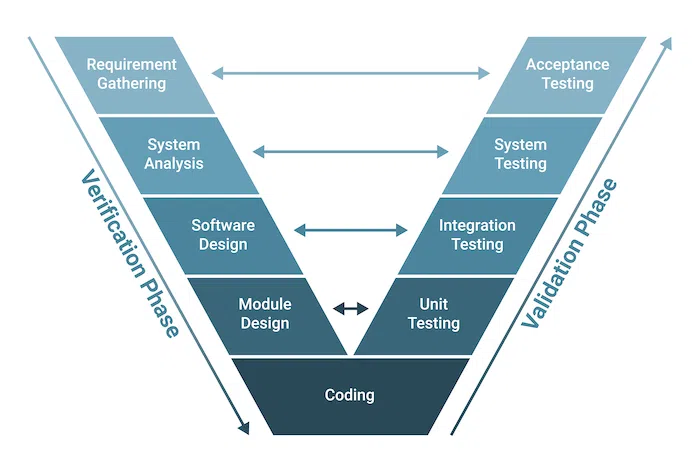
Detailed content of the V-model – Image Source: Built In
Use Cases:
- Projects where downtime and failures are unacceptably costly (e.g., medical software, aviation fleet management software).
3. Incremental & Iterative Model
The incremental development process is divided into multiple iterations (“Lego-style” modular software design is required!). In each iteration, new software modules are added, with no or minor changes to previously added components. The development process can be carried out in either a sequential or parallel manner. Parallel development speeds up the delivery process, whereas sequential development takes a long time and can increase software development costs.
With iterative development, software evolves and grows with each iteration. The software design remains consistent as each iteration builds on the preceding one.
Because software is given in pieces, there is no need for a detailed specification at the outset of the project, and tiny adjustments to requirements can be made during development. However, conditions cannot be drastically altered; essential requirements, particularly those for system architecture in the event of incremental development, must be established at the outset, as future integration of the provided software elements may become a problem.
Because tiny requirements amendments may be required during the development process, this software development model often involves some client input.
Use Cases:
- Large, mission-critical enterprise programs made out of loosely linked components like microservices or web services.
4. Spiral Model
The Spiral model emphasizes extensive risk analysis when you are making any software audit process. To get the most out of the model, you’ll need to work with people with a good risk assessment history. A typical Spiral iteration lasts about 6 months and includes four key activities: comprehensive planning, risk analysis, prototyping, and review of previously delivered parts. Spiral cycles that are repeated significantly lengthen project timelines.
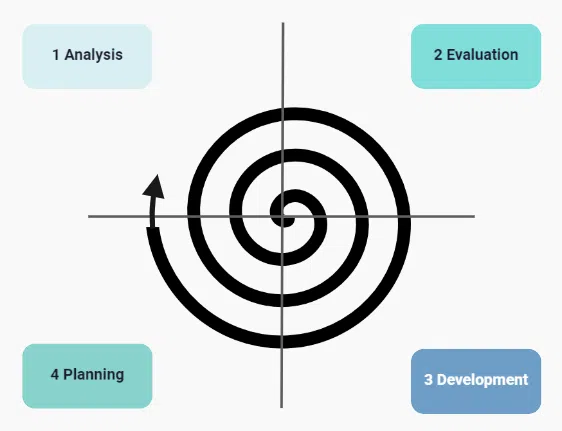
4 processes of the spiral model – Image Source: Kambu.
This software prototyping model involves the consumer heavily. They can participate in the cycle’s exploration and review stages. The customer’s revisions are not acceptable during the development stage.
Use Cases:
- Projects with ambiguous business needs or requirements that are too ambitious or inventive.
- Projects that are enormous and difficult to complete.
- The launch of a new service or product through research and development (R&D).
5. The Rational Unified Process (RUP)
The Rational Unified Process (RUP) is a framework that combines linear and iterative approaches. According to the paradigm, Inception, elaboration, construction, and transition are the four phases of the software development process. Except for Inception, each step is typically completed in numerous cycles. All basic development activities (requirements, design, etc.) are carried out parallel across these four RUP phases, though at varying intensities.
RUP aids in the development of solid and flexible solutions, although it is still slower and less adaptive than a pure Agile group (Scrum, Extreme Programming, etc.). Depending on the project requirements, the level of client interaction, documentation intensity, and iteration length may vary.
Use Cases:
- Large and high-risk projects, particularly use-case-based development and high-quality software development in a short period.
6. The Agile – Development Models
Of all software engineering models, Agile methodology in software engineering is used by more than 70% of businesses in their IT projects (source: VersionOne State of Agile Report 2021). Iterative development, intensive communication, and early client feedback are at the heart of Agile in general.
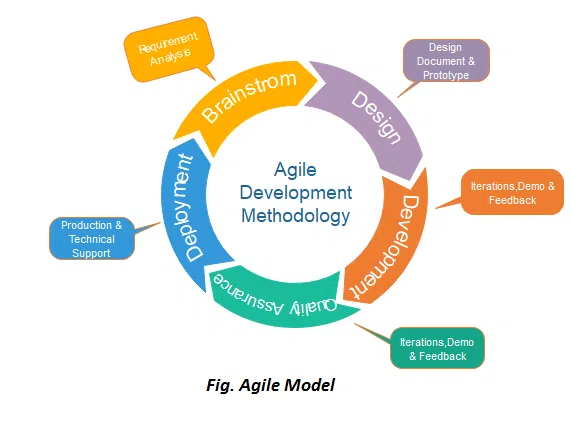
Agile model diagram – Image Source: Javatpoint.
Each Agile iteration usually lasts a few weeks and results in a fully functional software version. This group’s approaches place a greater emphasis on swiftly delivering an active element of the application. They give more attention to software testing activities than thorough software documentation (detailed requirement specification, detailed architecture description). This encourages rapid creation, but it also delays software transfer to the support team and complicates maintenance because it takes longer to detect a problem when there isn’t a clear program description.
Agile emphasizes close collaboration among team members as well as with consumers. After each iteration, stakeholders analyze the development progress and re-evaluate the priority of activities for the next iteration to maximize return on investment (ROI) and guarantee alignment with user needs and business goals.
As a result, Agile models are known for their frequent releases. They also help deliver applications that better suit customers’ expectations by allowing for continuous software enhancement through simple fixes and changes, quick updates, and feature additions. However, it is impossible to accurately predict the project’s budget, time, and personnel requirements because of a lack of precise planning and a willingness to change.
Use Cases:
- SDLC model for small projects or startup initiative that requires early input from end customers.
- Most mid-sized custom software development projects where business needs cannot be reliably converted into detailed software requirements.
- Large projects can be broken down into small functional components and developed slowly over time.
Which in this article, I will go through some of the most popular Agile Models like Scrum, Extreme Programming, and Kanban which you can find more about down below.
Scrum
Scrum is the most widely used Agile software development methodology. Iterations (‘sprints’) typically last 2-4 weeks and are preceded by comprehensive planning and prior sprint evaluation. After the sprint activities have been defined, no alterations are permitted.
7. Extreme Programming (XP)
A typical iteration in Extreme Programming (XP) lasts 1-2 weeks. If the team hasn’t started working with the appropriate software element yet, the paradigm enables changes to be made even after the iteration has begun. The supply of high-quality software is substantially hampered by such flexibility. To address the issue, XP recommends pair programming, test-driven development and automation, continuous integration (CI), limited releases, and simple software architecture and adhering to code standards.
8. Kanban
The absence of significant iterations is a fundamental differentiating aspect of Kanban. If they are used, they are kept to a minimum (‘daily sprints’). Instead, the focus is on visualizing the plan. The team uses the Kanban Board tool to keep track of all project activities, their quantity, accountable individuals, and progress. Increased transparency aids in a more accurate estimation of the most pressing tasks. Furthermore, because the model lacks a specific planning stage, a new change request can be made at any time.
Customer communication is ongoing; they can review work outcomes at any time, and project team meetings can take place daily. The model is commonly used in software support and evolution projects due to its nature.
9. Other Notable Software Development Models
Just like we have mentioned at the beginning of the article. There are many Software Development Models for you to choose from, and here are some honorable mentions.
9.1. RAD (Rapid Application Development) Model
The RAD Model, short for Rapid Application Development, is a variation of the Incremental Model. Several components are produced simultaneously as if they were smaller, individual projects when this model is implemented. The various elements are then put together to create operational prototypes.
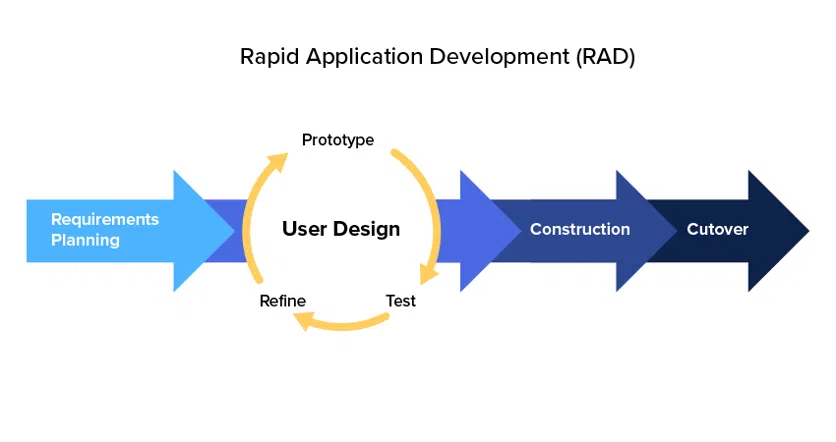
Operational process of the RAD model -Image Source: Kissflow.
- Advantages: The RAD Model provides for faster development and greater client feedback during the software development process.
- Disadvantages: The RAD Model’s application is limited because the project must be easily modularized into many steps. It also necessitates experienced developers with solid modeling and planning abilities. Issues with final component assembly could lead to unanticipated setbacks and the need to redesign components to fit correctly with the rest.
9.2. Prototype Model
The Prototype Model is based on generating software applications or system software prototypes used to visualize various software components. This model is intended to close the gap between misunderstood needs by allowing for extensive engagement and input with the user.
- Advantages: With a high level of user interaction, the Prototype Model can save time and money.
- Disadvantages: This model may produce misunderstanding among users as to the difference between a prototype and a finished product, and it may add unnecessary development time to prototype development.
Which SDLC Model Is Right For You?
Each of these SDLC Models offers a unique process for the variety of project challenges you will encounter in your career. Finding the right one depends heavily on not just the expected outcome, but the parameters by which the project is executed.
In today’s fast-paced tech landscape, the choice of software development models directly impacts project outcomes, with studies showing that organizations using Agile methodologies experience 60% faster time to market (source: PMI Pulse of the Profession 2021). Additionally, 97% of organizations believe project management is critical to business performance (PMI). By assessing your organization’s unique needs, you can better choose a software development model that aligns with your goals and resources.
What is software process model?
Software process models are standardized frameworks that outline the stages and steps involved in the development of software applications. These models provide a structured approach to software development, ensuring that all essential phases are systematically addressed.
Looking To Find A Trusted Tech Partner?
Savvycom specializes in tech consulting, end-to-end product development, and software outsourcing, harnessing digital technologies to fuel business growth across diverse industries. Committed to delivering high-quality software solutions and products, we also provide a comprehensive range of related professional software development services tailored to meet your specific needs.
Savvycom is right where you need. Contact us now for further consultation:
- Phone: +84 24 3202 9222
- Hotline: +1 408 663 8600 (US); +612 8006 1349 (AUS); +84 32 675 2886 (VN)
- Email: [email protected]


